Abstract
Hydnum (Hydnaceae, Cantharellales), one of the edible ectomycorrhizal mushrooms, is of considerable ecological and economic importance. Although previous studies have focused on the genus in China, the diversity still remains incompletely understood. In the present study, in addition to the known species from China being reviewed, six phylogenetic species from the country were described/redescribed, which included a new species: H. erectum, and five known taxa: H. cremeoalbum, H. minus, H. orientalbidum, H. tenuistipitum, and H. treui; H. treui is new to China. Detailed descriptions, color photographs of fresh basidiomata, and line drawings of microstructures of them are presented. A key to the accepted species of Hydnum in China is also provided.
1. Introduction
Hydnum L. (Hydnaceae, Cantharellales), with the type species H. repandum L., is morphologically characterized by its white to brownish-orange stipitate basidiomata with spinous hymenophore, smooth, hyaline, thin-walled, globose, ovoid to ellipsoidal basidiospores, and clavate to suburniform, stichic basidia with one to eight sterigmata [1,2,3,4,5,6,7,8]. It is a genus, forming ectomycorrhizal associations with a variety of host plants including members of the Fagales, Pinaceae, Malvaceae, Dipterocarpaceae, Salicaceae, and Myrtaceae, which plays an important role in maintaining the biodiversity of forest ecosystems [1,9,10]. In addition to the ecological value, species of Hydnum also contain polyphenolic compounds with pharmacological effects such as antioxidant and antimicrobial activities [9,11]. Moreover, they are edible and have been collected and consumed by humans for centuries [12].
When Linnaeus established Hydnum in 1753, it included all species of mushroom-forming fungi with a spinose hymenophore [1,9]. Molecular phylogenetic analyses suggested that spinose hymenophore has independently evolved many times in distant taxa [13]; thus, many species previously included in Hydnum have been moved to other genera, such as Hericium Pers., Phellodon P. Karst., Sarcodon Quél. ex P. Karst. [14]. Up to now, Hydnum s.s. has been divided into five subgenera: Alba Niskanen & Liimat., Brevispina T. Cao & H. S. Yuan, Hydnum L., Pallida Niskanen & Liimat., and Rufescentia Niskanen & Liimat. [1,15]. Within subg. Hydnum, two sections, viz. Hydnum L. and Olympica Niskanen & Liimat. are included; subg. Rufescentia also includes two sections: Magnorufescentia Niskanen & Liimat. and Rufescentia Niskanen & Liimat; sect. Rufescentia currently includes three subsections: Mulsicoloria Niskanen & Liimat., Rufescentia Niskanen & Liimat., and Tenuiformia Niskanen & Liimat. [1].
Species diversity of Hydnum was abundant, approximately 60 species of the genus having been described from throughout the world [1,5,9,11,12,16,17,18,19]. In China, species of the genus have also received attention from mycologists. Earlier, only 3 taxa of Hydnum, viz. H. repandum, H. repandum var. album, and H. rufescens Pers., were reported in the country [15,20,21]. Then, Feng et al. recognized 18 phylogenetic species of the genus [9]. Two recent studies indicated that there are 19 species confirmed to be distributed in China [15,22].
Previous studies indicated that Hydnum species were mainly found in temperate regions of the world; few taxa were reported from subtropical/tropical forests [1,4,9,12,23,24,25,26,27,28,29,30]. It is well-known that subtropical/tropical China is a biodiversity hotspot, and with more field investigations in the region, more species of the genus will be uncovered. Recently, several collections of Hydnum were made from subtropical/tropical China, and these specimens were studied using morphological and molecular phylogenetic analyses, aiming to (i) describe new taxa and uncover more species of Hydnum in China; (ii) amend descriptions of some Hydnum species; (iii) provide an overview the Hydnum species in China.
2. Materials and Methods
2.1. Morphological Studies
The studied specimens were collected from Hainan, Hunan, and Zhejiang Provinces in China and deposited in the Fungal Herbarium of Hainan Medical University (FHMU), Haikou City, Hainan Province, China. Fresh specimens were used to make field records and digital photographs. Color documentation of fresh materials followed Kornerup and Wanscher [31]. Observations and measurements of microscopic features were made in 5% KOH solution and stained with 1% Congo Red [4]. Sections of the pileipellis were taken from the pileus between the center and margin. The number of measured basidiospores is presented as n/m/p, where “n” represents the total number of basidiospores measured from “m” basidiomata of “p” collections. Dimensions of basidiospores were presented in the form (a–) b–e–c (–d), where the range b–c contains at least 90% of the measured values (5th to 95th percentile), “a” and “d” are the extreme values, and “e” refers to the average length/width of basidiospores. Q refers to the length/width ratio of basidiospores; Qm refers to the average Q of basidiospores and is presented with standard deviation [32,33]. The analyses of basidiospore size were constructed using SPSS Statistics Version 17.0 [34]. The terms referring to the size of basidioma were based on Bas [35].
2.2. Molecular Procedures
Total genomic DNA was obtained with the Plant Genomic DNA Kit (KANGWEI Company, Taizhou, China) from materials dried with silica gel, according to the manufacturer’s instructions. The primer pairs used for amplification were: LR0R/LR5 [36,37] for the nuclear ribosomal large subunit RNA (28S) and the nuclear rDNA region encompassing the internal transcribed spacers 1 and 2, along with the 5.8S rDNA (ITS), with ITS5/ITS4 [38]. PCR conditions followed the program of Zhang et al. [32]. PCR products were checked on 1% (w/v) agarose gels, and positive reactions with a bright single band were purified and directly sequenced using an ABI 3730xl DNA Analyzer (Guangzhou Branch of BGI, Guangzhou, China) with the same primers used for PCR amplifications [32,33]. DNA sequences were compiled by BioEdit [39] and then deposited in GenBank.
2.3. Dataset Assembly
Twenty-four DNA sequences (twelve of 28S and twelve of ITS) from thirteen specimens were newly generated. For the concatenated dataset, the sequences of 28S and ITS from the new collections were aligned with sequences of taxa of Hydnum from previous studies and GenBank/UNITE (Table 1). Sequences of H. elatum Massee, H. sp. (FRI62832), H. sp. 17 BF-2016 (PDD93275, PDD98029, PERTH07830742, PERTH08072957, and GD1588), H. sp. 18 BF-2016 (PDD94968, GD1590, and GD1589), and H. sp. 19 BF-2016 (PERTH07608543, PERTH08018413, PERTH08091676, and PERTH08093865) were excluded from analyses due to the distinct genetic divergences of their ITS sequences, which was also noted by Feng et al., Niskanen et al., and Sugawara et al. [1,9,14]. Sistotrema muscicola (Pers.) S. Lundell was chosen as outgroup following Cao et al. [15]. To test for phylogenetic conflict between the two genes in the combined dataset, the phylogenetic trees based on 28S and ITS datasets were analyzed and conducted using the ML method to detect the topologies of genes used. The results of analyses showed that the different gene fragments were not in conflict. Then, the two datasets (28S and ITS) were aligned with MUSCLE v3.6 [40] and concatenated using Phyutility v2.2 for further analyses [41].

Table 1.
Taxa, vouchers, locations, and GenBank/UNITE accession numbers of DNA sequences used in this study.
2.4. Phylogenetic Analyses
The combined nuclear dataset (28S + ITS) was analyzed with maximum likelihood (ML) and Bayesian Inference (BI). Maximum likelihood tree generation and bootstrap analyses were performed with the program RAxML 7.2.6, running 1000 replicates combined with an ML search. Bayesian analysis with MrBayes 3.1, implementing the Markov Chain Monte Carlo (MCMC) technique and parameters predetermined with MrModeltest 2.3, was performed [32,33]. The best-fit likelihood model for 28S and ITS was GTR + I + G and GTR + I + G, respectively. Bayesian analysis of the combined nuclear dataset (28S + ITS) was run for 45 million generations, and the average deviation of split frequencies was 0.005618. Trees sampled from the first 25% of generations were discarded as burn-in, and Bayesian posterior probabilities (PP) were then calculated for a majority consensus tree of the retained Bayesian trees [32,33].
3. Results
3.1. Molecular Data
The combined dataset (28S + ITS) consisted of 255 taxa with 1454 nucleotide sites, and the alignment was submitted to TreeBASE (S31163). The phylogram with branch lengths generated from RAxML and support values (BS and PP) are shown in Figure 1. The topologies of phylogenetic trees generated from ML and BI analyses were identical, although statistical support for some branches showed slight differences.
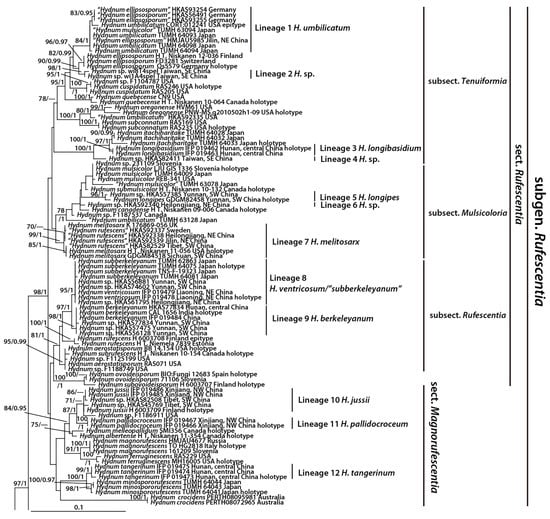
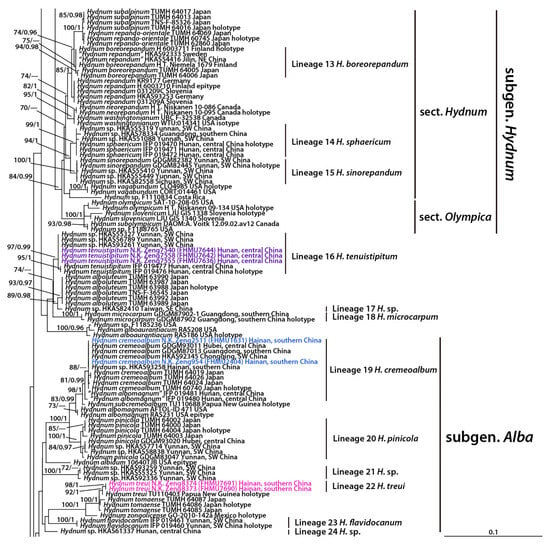
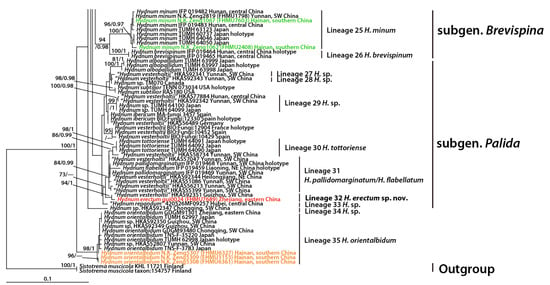
Figure 1.
A phylogram of Hydnum inferred from a two-locus (28S and ITS) dataset using RAxML. BS (≥70%) and PP (≥0.95) are indicated above the branches. Newly generated sequences are in color; SW: Southwestern, NE: Northeastern, NW: Northwestern, SE: Southeastern.
Existing molecular data indicated that the Chinese collections of Hydnum were grouped into 35 isolated lineages (Figure 1). A total of six lineages (16, 19, 22, 25, 32, and 35), including our new specimens, were identified. Lineage 16, with strong statistical support (BS = 97%, PP = 0.99), was comprised of the holotype (IFP 019476) and one specimen (IFP 019477) of H. tenuistipitum T. Cao & H.S. Yuan, three new collections (FHMU7644, FHMU7636, and FHMU7642) from central China, and three unidentified collections (HKAS56789, HKAS55327, and HKAS93261); lineage 19, with high statistical support (BS = 81%, PP = 0.99), included the holotype (TUMH 60740) of H. cremeoalbum Liimat. & Niskanen, two new specimens (FHMU2404 and FHMU1631) from southern China, four collections (HKAS92345, TUMH 64026, TUMH 64019, and TUMH 64024) identified as H. cremeoalbum, two specimens (IFP 019480 and IFP 019481) identified as H. albomagnum Banker, and one unidentified collection (HKAS93258) from southern China; lineage 22, with high statistical support (BS = 92%, PP = 1), was comprised of the holotype (TU110403) of H. treui Tedersoo, Liimat. & Niskanen, and two new collections (FHMU7690 and FHMU7691) from southern China; lineage 25, with strong statistical support (BS = 100%, PP = 1), included the holotype (TUMH 60737) and six collections (TUMH 63123, TUMH 64046, TUMH 64050, IFP 019482, FHMU1798, and IFP 019483) of H. minus Yanaga & N. Maek, and two new specimens (FHMU7603 and FHMU2408) from southern China; lineage 32, with high statistical support (BS = 94%, PP = 1), included one new specimen (FHMU7689) from eastern China, and one collection (HKAS92351) identified as H. vesterholtii; lineage 35, with strong statistical support (BS = 98%, PP = 1), included the holotype (TUMH 62998) and three specimens (TNS-F-35220, TNS-F-3783, and TUMH 62997) of H. orientalbidum R. Sugaw. & N. Endo, three new collections (FHMU6327, FHMU3153, and FHMU6361) from southern China, and three unidentified collections (HKAS52807, HKAS92350, and HKAS92349) from China (Figure 1).
3.2. Taxonomy
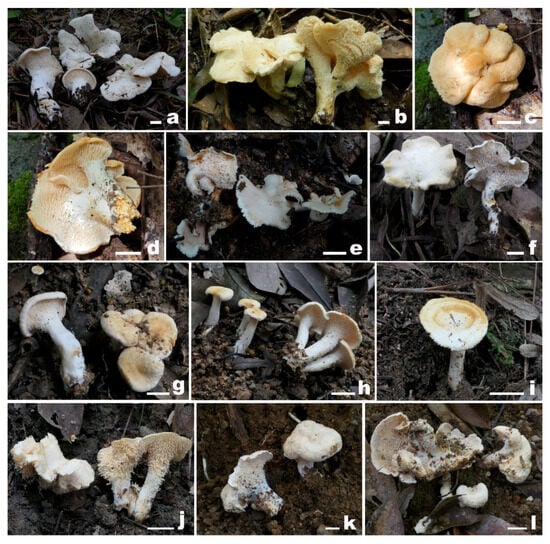
Figure 2.
Basidiomata of Hydnum species. (a,b) Hydnum cremeoalbum (a) from FHMU2404; (b) from FHMU1631); (c,d) Hydnum erectum (FHMU7689, holotype); (e,f) Hydnum minus (e) from FHMU2408; (f) from FHMU7603); (g,h) Hydnum orientalbidum (g) from FHMU6327; (h) from FHMU6361; (i,j) Hydnum tenuistipitum (i) from FHMU7642; (j) from FHMU7636); (k,l) Hydnum treui (k) from FHMU7690; (l) from FHMU7691. Scale bars = 1 cm. Photographs by N.K. Zeng.
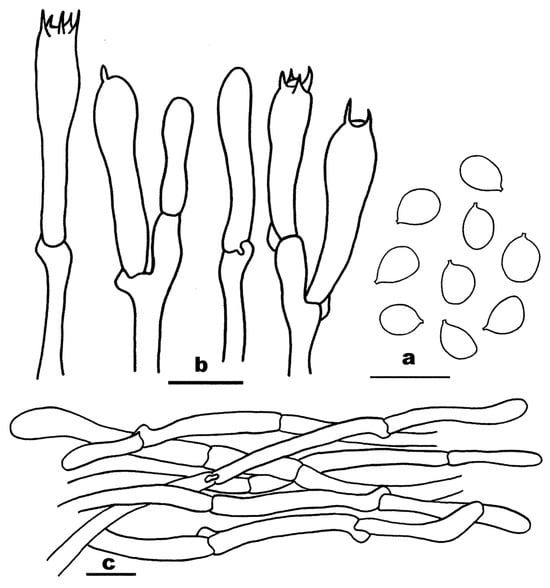
Figure 3.
Microscopic features of Hydnum cremeoalbum (FHMU1631). (a) Basidiospores. (b) Basidia. (c) Pileipellis. Scale bars = 10 μm. Drawings by Y.Z. Zhang.
MycoBank: MB 553875.
Description—Basidiomata medium to large-sized, usually branched, sometimes fused with the pileus of the same branch, solitary to gregarious, and fleshy. Pileus 6–9 cm in diameter, round to reniform, irregular when old, becoming somewhat infundibuliform or slightly wavy; surface dry, smooth to irregularly rugged, glabrous, cream white to pale cream (2A2–3) or cream (3A3), whitish (2A1); margin entire and decurved when young, straight to slightly waved in age, white (2A1) to pale cream (2A3); context approximately 4 mm thick, white (2A1), unchanging in color when injured. Hymenophore hydnoid, spines approximately 4 mm long, shortest near the pileus margin, slightly decurrent to decurrent, subulate to cylindrical, acute, straight, solitary, crowded, cream white to pale cream (1A2–2A2), pale yellowish-brown (2A5–3A5). Stipe 4–6 × 1.3–2 cm, central or eccentric, cylindrical to subcylindrical, robust, sometimes branched, slightly incurved, solid; surface dry, glabrous, whitish (1A1) to cream white (1A2), pale yellow (2A4). Odor not distinctive.
Basidiospores [40/6/2] 4.5–5.2–5.5 (–6) × 3–4.1–4.5 μm, Q = 1.11–1.29–1.43 (–1.83), Qm = 1.29 ± 0.13, subglobose to broadly ellipsoid or ovoid, slightly thick-walled (up to 1 μm), inamyloid, smooth, hyaline in KOH. Basidia 22–30 × 3.5–6.5 μm, subcylindric, clavate to suburniform, slightly inflated at the apex, slightly thin-walled (up to 0.5 μm), yellowish in KOH; sterigmata 1–5, somewhat curving. Cystidia absent. Pileipellis a cutis, composed of subcylindric hyphae measuring 2–8 μm wide, interwoven to subparallel, and yellowish in KOH; terminal hyphae 16–38 × 2–5.5 μm, thin-walled (less than 5 μm), slightly inflated at the apex or septum. Clamp connections present in all tissues.
Habitat—Gregarious on the ground in forests dominated by fagaceous trees.
Known distribution—Japan, southern China (Hainan and Guangdong Provinces), and central China (Hubei Province); probably found in Hunan Province and Chongqing Municipality (Figure 1).
Specimens examined—CHINA. Yunnan Province: Kunming City, elev. 1950 m, 27 July 2011, N.K. Zeng954 (FHMU2404); Hainan Province: Yinggeling of Hainan Tropical Rainforest National Park, elev. 650 m, 3 August, 2015, N.K. Zeng2511 (FHMU1631).
Notes—Hydnum cremeoalbum was originally described from Japan [1], then recently reported from Guangdong and Hubei Provinces, China [22]. In the present study, it was also found to be distributed in Hainan and Yunnan Provinces of China. The species is characterized by a cream white to cream, infundibuliform, and large pileus, a robust and branched stipe, a decurrent hymenophore, long spines (up to 4 mm), subglobose to ovoid basidiospores, and association with fagaceous trees. In addition, intraspecific variations of H. cremeoalbum were observed; for example, the Japanese specimens have smaller basidiomata (pilei 3–7 cm diameter), non-branched stipitis, and larger basidiospores measuring 5–7 × 3.5–5.5 μm [1].
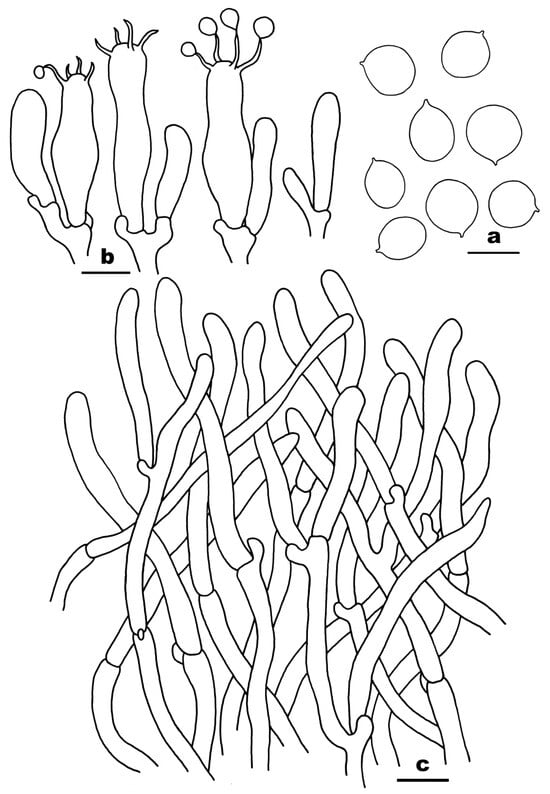
Figure 4.
Microscopic features of Hydnum erectum (FHMU7689, holotype). (a) Basidiospores. (b) Basidia. (c) Pileipellis. Scale bars = 10 μm. Drawings by H.Z. Qin.
MycoBank: MB 851242.
Etymology: Latin “erectum” refers to the pileipellis, composed of mostly erect hyphae.
Diagnosis: Differs from other species of H. subgen. Pallida through a creamy yellow to pale salmon, velutinate pileus, basidia inflated in the center, and a trichodermal pileipellis mostly composed of erect hyphae.
Holotype: China. Zhejiang Province: Qingyuan County, Zuoxi Town, Yinjiang Village, elev. 800 m, 15 August 2023, gui0024 (FHMU7689). GenBank accession numbers: 28S = OR722669, ITS = OR722666.
Description—Basidiomata small, solitary, concrescent, and fleshy. Pileus 3.5–4.5 cm in diameter, convex to plano-convex, and shallowly raised in the center; surface irregularly bumpy, dry, velutinate, creamy yellow (3A3–4) to pale salmon (1A2–2A2), darker in the center; margin entire, incurved, and slightly creamy yellow (1A2–3) to whitish (1A1). Context approximately 5 mm thick in the center of the pileus, fleshy, and white (2A1), unchanging in color when injured. Hymenophore hydnoid, spines 1–2 mm long, shortest near the pileus margin and stipe, non-decurrent to slightly decurrent, subulate to cylindrical, acute, straight to slightly curving, white to pale salmon (1A2). Stipe 2.5–3 × 1.2–1.5 cm, central, subcylindrical, solid, and branched; surface dry, smooth, white to slightly salmon (1A2). Odor is not distinctive.
Basidiospores [20/1/1] 6.5–7.33–8 × 5.5–6.68–7.5 (–8) μm, Q = 1–1.1–1.25 (–1.27), Qm = 1.1 ± 0.09, globose, subglobose to broadly ellipsoid, slightly thick-walled (up to 1 μm), smooth, and hyaline in KOH. Basidia 22–40 × 5–12 μm, subcylindric to subclavate, often inflated in the center or vertex, slightly thick-walled (up to 1 μm), colorless in KOH, and most contained fine granular inclusions, sometimes with large guttules; sterigmata 2–4, up to 8 μm long, and 2 μm wide at the base, somewhat curving. Cystidia absent. Pileipellis a trichoderm, mostly composed of erect hyphae measuring 3–12 μm wide, subcylindric, and hyaline to yellowish in KOH; terminal hyphae 29–75 × 1.5–4 μm, slender, subcylindric to subclavate, slightly thick-walled (up to 1 μm), and slightly inflate at the apex or septum. Clamp connections present in all tissues.
Habitat—Solitary and concrescent on the ground in forests dominated by fagaceous trees.
Known distribution—Eastern China (Zhejiang Province); probably also found in southwestern China (Guizhou Province) (Figure 1).
Notes—In China, H. erectum was misidentified as H. vesterholtii [9]; however, the latter has an ocher and slightly hygrophanous pileus, usually depressed in the center, a velutinous stipe often staining ocher when handled, presence of a citric odor, longer basidia measuring 42–68 μm, and a cutis-trichoderm pileipellis [17]. Morphologically, H. erectum is also similar to some members of subgen. Pallida, viz., H. albopallidum R. Sugaw. & N. Endo, H. flabellatum T. Cao & H. S. Yuan, H. pallidomarginatum T. Cao & H. S. Yuan, and H. tottoriense R. Sugaw. & N. Endo. However, H. albopallidum has a white and glabrous pileus turning pale ocher to ocher early when bruised, a vimineous stipe staining pale yellow to pale ocher when bruised, larger basidiospores measuring 8–9.5 × 7–8 μm, a mixocutis pileipellis, and grows under a mixed forest of Abies Mill., Betula L., and Tsuga (Endl.) Carrière [14]; H. flabellatum differs from H. erectum by having a flabelliform to semicircular, glabrous pileus, often with some brownish orange scales, a stipe staining orange-white when injured, larger basidiospores measuring 8.5–9.5 × 6.5–7.8 μm, a pileipellis composed of subparallel hyphae, and association with trees of Pinaceae [15]; H. pallidomarginatum has a pale orange and glabrous pileus, an orange-white stipe staining brownish when bruised, broadly ellipsoid and larger basidiospores measuring 8.2–9.8 × 6.5–7.8 μm, longer basidia (32–65 μm), and a pileipellis composed of interwoven hyphae [15]; H. tottoriense differs from H. erectum by having a glabrous and pale yellow pileus slowly staining ocher to brownish orange when handled, longer spines (up to 6 mm), larger basidiospores measuring 7.5–9.5 × 6.5–8.5 µm, and a mixocutis pileipellis [14].
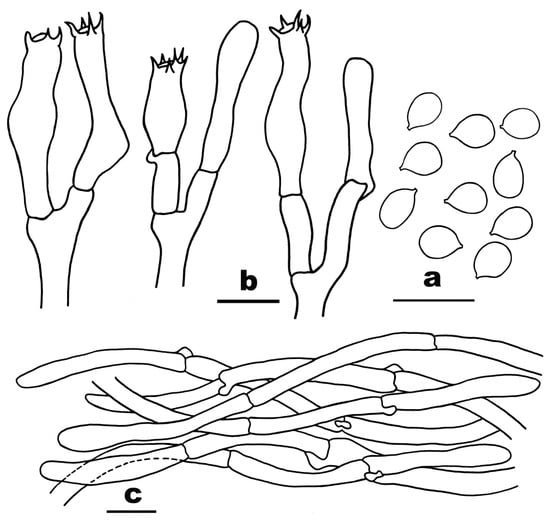
Figure 5.
Microscopic features of Hydnum minus (FHMU2408). (a) Basidiospores. (b) Basidia. (c) Pileipellis. Scale bars = 10 μm. Drawings by Y.Z. Zhang.
MycoBank: MB 808762.
Description—Basidiomata small, gregarious, and sometimes fused, fleshy. Pileus 3–4.5 cm diameter, convex to plano-convex or irregular when young, then becoming plane, slightly umbilicate, or infundibuliform; surface dry, glabrous, smooth, white (2A1), cream white (2A2) to cream (3A3) when young, and pale brown (5B6–7) in age; margin entire to lobed, wavy, white (2A1) to cream white (2A2). Context 2–4 mm thick in the center of the pileus, translucent or watery, white, and turning reddish-brown (6B6) to red (8B6) slowly when injured. Hymenophore hydnoid, spines 2–4 mm long, shortest near the pileus margin, slightly decurrent to decurrent, conical to cylindrical, adnate, crowded, white (1A1) to cream white (1A2). Stipe 2–6.5 × 0.2–1 cm, central or eccentric, cylindrical to subcylindrical, often incurved, solid when young, and hollow in age; surface dry, smooth, glabrous, white (2A1) to pale cream (2A2), turning pale brown (4A4–5B5) gradually when injured. Odor not distinctive.
Basidiospores [37/13/3] 4–4.72–5 × 3–3.68–4 μm, Q = 1.13–1.29–1.43 (–1.5), Qm = 1.29 ± 0.10, broadly ellipsoid to ellipsoid or ovoid, slightly thick-walled (up to 1 μm), smooth, and yellowish in KOH. Basidia 14–28 × 5–8 μm, clavate to subclavate, slightly thin-walled (up to 5 μm), and hyaline; sterigmata 3–6, up to 3.5 μm long, 1.5 μm wide at the base, somewhat curving. Cystidia absent. Pileipellis a cutis, composed of subcylindric hyphae measuring 4–10 μm wide, interwoven to subparallel, and yellowish in KOH; terminal hyphae 28–40 × 3–5 μm, slightly thin-walled (up to 5 μm), and slightly inflate at the apex or septum. Clamp connections present in all tissues.
Habitat—Gregarious on the ground in forests dominated by fagaceous trees.
Known distribution—Japan, southern China (Hainan Province), southwestern China (Yunnan Province), and central China (Hunan Province).
Specimens examined—CHINA. Hainan Province: Jianfengling of Hainan Tropical Rainforest National Park, elev. 850 m, 5 July 2012, N.K. Zeng1062, 1067 (FHMU2408, 7603); Yunnan Province: Wuding County, Gaoqiao Town, elev. 1980 m, 20 August 2016, N.K. Zeng2819 (FHMU1798).
Notes—Hydnum minus was originally described from Japan [5] and subsequently reported from Hunan Province, central China [15]. In the present study, it was also found to be distributed in Hainan and Yunnan Provinces of China. The species is characterized by a small, slightly umbilicate, cream-white pileus with a lobed to wavy margin, a translucent or watery, white context turning reddish-brown to red slowly when injured, long spines (up to 4 mm), a pale cream stipe turning pale brown gradually when injured, and broadly ellipsoid to ellipsoid basidiospores. In addition, intraspecific variations of H. minus were observed; for example, the Japanese specimens have smaller basidiomata (pilei 1–2.5 cm diameter) and shorter spines (0.5–1.7 mm) [5].
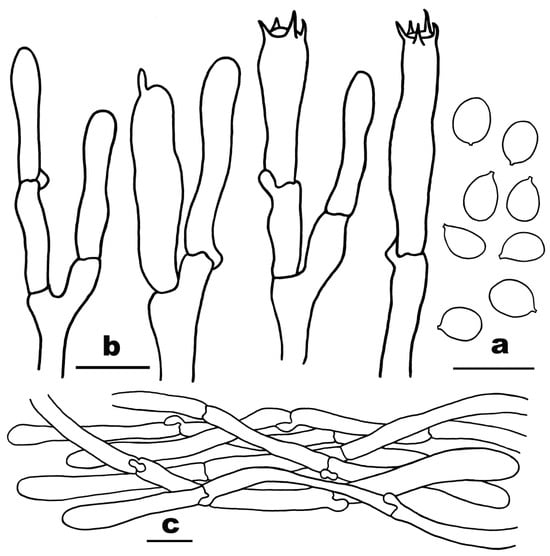
Figure 6.
Microscopic features of Hydnum orientalbidum (FHMU3153). (a) Basidiospores. (b) Basidia. (c) Pileipellis. Scale bars = 10 μm. Drawings by Y.Z. Zhang.
MycoBank: MB 839853.
Description—Basidiomata very small to small, solitary to gregarious, sometimes fused, fleshy. Pileus 0.8–3 cm in diameter, convex to plano-convex, and shallowly depressed in the center; surface dry, glabrous, and smooth, creamy yellow (2A2–4A4) to pale orange (5A3–4), slightly darker in the center; margin entire, sometimes lobed, incurved, and sometimes wavy, white (1A1) to pale cream (1A2). Context 2–3 mm thick in the center of the pileus, fleshy, and white (2A1), unchanging in color when injured. Hymenophore hydnoid, spines 1–2 mm long, shortest near the pileus margin and stipe, usually decurrent, evenly distributed, crowded, subulate to cylindrical, acute, straight to slightly flexuous, solitary, and creamy yellow (2A4) to white (2A1). Stipe 1.5–3.5 × 0.4–1.2 cm, central, cylindrical to subcylindrical, slightly incurved or straight; surface dry, smooth, and white (2A1), sometimes with a creamy white (2A2) tone near the base. Odor not distinctive.
Basidiospores [60/13/3] 4.5–5.1–5.5 × 3.5–4.1–4.5 μm, Q = 1.11–1.24–1.43 (–1.57), Qm = 1.24 ± 0.09, ovoid to broadly ellipsoid, slightly thick-walled (up to 1 μm), inamyloid, smooth, colorless in KOH. Basidia 18–28 × 3–7 μm, subcylindric, subclavate to clavate, slightly thin-walled (up to 0.5 μm), hyaline; sterigmata 3–5, up to 3.5 μm long, somewhat curving. Cystidia absent. Pileipellis a cutis, composed of hyphae, interwoven to subparallel, 3.5–9 μm wide, yellowish in KOH; terminal hyphae 38–50 × 3–7 μm, cylindrical, thin-walled (less than 5 μm), and slightly inflate at the apex or septum. Clamp connections present in all tissues.
Habitat—Solitary or gregarious on the ground in forests dominated by fagaceous trees.
Known distribution—Japan, southern China (Hainan Province), southwestern China (Sichuan Province and Chongqing Municipality), and eastern China (Zhejiang Province); probably found in Yunnan and Guizhou Provinces (Figure 1).
Specimens examined—CHINA. Hainan Province: Changjiang Li Autonomous County, Bawangling of Hainan Tropical Rainforest National Park, elev. 650 m, 28 July 2021, N.K. Zeng5307, 5308, 5309 (FHMU6327, 6361, 3153).
Notes—Hydnum orientalbidum was originally described from Japan [14] and subsequently reported from Sichuan and Zhejiang Provinces and Chongqing Municipality, China [22]. In the present study, it was also found to be distributed in Hainan, southern China. The species is characterized by a small, creamy yellow to pale orange pileus with a white margin, short spines, a white and short stipe, ovoid to broadly ellipsoid basidiospores, and association with fagaceous trees. In addition, intraspecific variations of H. orientalbidum were observed,; for example, the Japanese specimens have larger basidiomata (pilei up to 5.5 cm diameter) and longer spines (up to 6 mm) [14].
Hydnum tenuistipitum T. Cao & H.S. Yuan, Studies in Mycology 99 (no. 100121): 53, 2021. (Figure 2i,j and Figure 7).
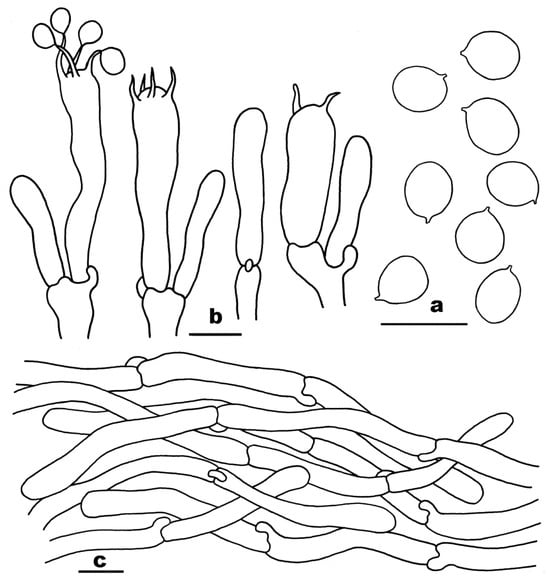
Figure 7.
Microscopic features of Hydnum tenuistipitum (FHMU7644). (a) Basidiospores. (b) Basidia. (c) Pileipellis. Scale bars = 10 μm. Drawings by H.Z. Qin.
MycoBank: MB 839422.
Description—Basidiomata very small to small, solitary to gregarious, and sometimes fused, fleshy. Pileus 1–3 cm in diameter, plano-convex to slightly infundibuliform; surface smooth, dry, white (1A1) to creamy white (1A2–3); margin lobed, incurved to irregularly wavy, white (1A1) to creamy white (1A2–3). Context 1–3 mm thick in the center of the pileus, fleshy, and white (2A1), unchanging in color when injured. Hymenophore hydnoid, spines approximately 1 mm long, shortest near the pileus margin and stipe, decurrent to strongly decurrent, somewhat near the stipe base, crowded, subulate to cylindrical, acute, straight, somewhat adnate, white (1A1), creamy white (1A2–3) to yellowish-white (3A3–4). Stipe 1.5–3.5 × 0.4–1 cm, central, cylindrical to subcylindrical, solid, becoming hollow with age, slightly incurved or straight; surface dry, smooth, white (1A1) to cream white (1A2). Odor not distinctive.
Basidiospores [60/8/3] (5–) 5.5–6.28–7 × 4.5–5.62–6 (–7) μm, Q = 1–1.12–1.2 (–1.3), Qm = 1.12 ± 0.01, globose, subglobose to broadly ellipsoid, slightly thick-walled (up to 1 μm), smooth, and some contain granular contents, yellowish in KOH. Basidia 19–41 × 3–10 μm, subcylindric, clavate to subclavate, slightly thick-walled (up to 1 μm), and yellowish in KOH, most containing fine granular inclusions, sometimes with large guttules; sterigmata 2–5, up to 8 μm long, 2 μm wide at the base, somewhat curving. Cystidia absent. Pileipellis a cutis, interwoven to subparallel, 3–12 μm wide, and yellowish in KOH; terminal hyphae 30–65 × 4–6 μm, cylindrical, slightly thick-walled (up to 1 μm), and slightly inflate at the apex or septum. Clamp connections present in all tissues.
Habitat—Solitary or gregarious on the ground in forests dominated by Pinus massoniana Lamb.
Known distribution—Central China (Hunan Province); probably found in southwestern China (Yunnan Province) (Figure 1).
Specimens examined—CHINA, Hunan Province: Tongdao Dong Autonomous County, Longcheng Town, Ganxi Village, elev. 450 m, 10 April 2023, N.K. Zeng7540, 7555, 7558 (FHMU7644, 7636, 7642).
Notes—Hydnum tenuistipitum was originally described from Hunan Province, central China [15]. The species was redescribed based on our new collections, which is characterized by a small, creamy white pileus with a lobed margin, short spines (1 mm long), a strongly decurrent hymenophore, a short stipe unchanging in color when injured, globose to subglobose basidiospores, and association with P. massoniana. In addition, intraspecific variations of H. tenuistipitum were observed; for example, the collections cited by Cao et al. have orange-white pilei, longer stipitis (up to 6 cm) staining pale orange when injured, larger basidiospores measuring 6.8–7.2 × 5.5–6.5 μm, and longer basidia (up to 63 μm) [15].
Hydnum treui Tedersoo, Liimat. & Niskanen, Mycologia 110 (5): 897, 2018. (Figure 2k,l and Figure 8).
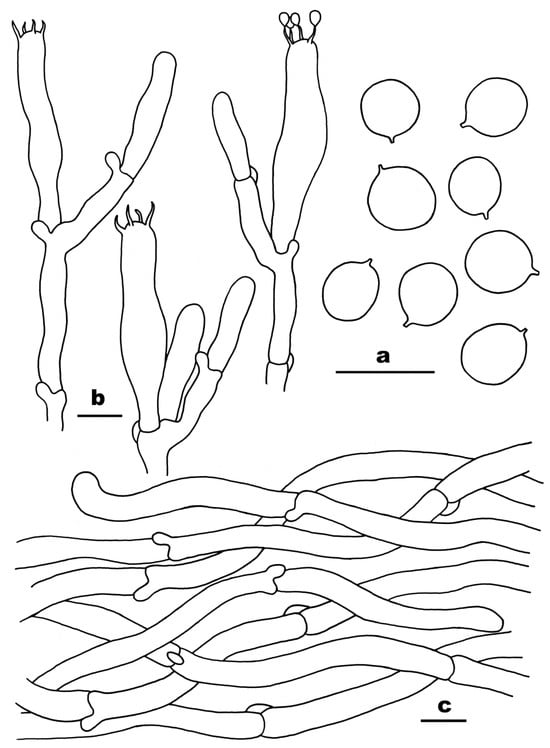
Figure 8.
Microscopic features of Hydnum treui (FHMU7690). (a) Basidiospores. (b) Basidia. (c) Pileipellis. Scale bars = 10 μm. Drawings by H.Z. Qin.
MycoBank: MB 553877.
Description—Basidiomata small to medium-sized, solitary to gregarious, usually fused, fleshy. Pileus 2.8–5.7 cm in diameter, convex to plano-convex or irregular, slightly infundibuliform; surface smooth, dry, unobviously ribbed, white (1A1) to creamy white (2A2–3A2); margin entire, incurved to slightly wavy, and white (1A1). Context 2–10 mm thick in the center of the pileus, fleshy, white to pinkish (5A2), unchanging in color when injured. Hymenophore hydnoid, spines 1–4 mm long, shortest near the pileus margin and stipe, non-decurrent to slightly decurrent, crowded, subulate to cylindrical, acute, straight, somewhat adnate, white (1A1) and creamy white (1A2) to yellowish (2A3). Stipe 1.6–2.6 × 0.8–1.3 cm, central, cylindrical to subcylindrical, slightly hollow to hollow; surface dry, smooth, white (1A1) to yellowish-white (1A4–5). Odor strong, sweetish, and fragrant.
Basidiospores [40/5/2] 6–6.44–7 (–7.5) × 5–5.88–6.5 (–7) μm, Q = 1–1.1–1.2 (–1.3), Qm = 1.1 ± 0.07, globose to subglobose, sometimes broadly ellipsoid, slightly thick-walled (up to 1μm), smooth, and yellowish in KOH. Basidia 21–59 × 6–10.5 μm, subcylindric, clavate to subclavate, slightly thick-walled (up to 1 μm), and colorless in KOH; sterigmata 2–4, up to 7 μm long, 2 μm wide at the base, somewhat curving. Cystidia absent. Pileipellis a cutis, interwoven to subparallel, 2–11 μm wide, and colorless in KOH; terminal hyphae 23–74 × 4–6 μm, cylindrical, slightly thick-walled (0.5–1 μm), and slightly inflate at apex or septum. Clamp connections present in all tissues.
Habitat—Solitary or gregarious on the ground in forests dominated by fagaceous trees.
Known distribution—Papua New Guinea and southern China (Hainan Province).
Specimens examined—CHINA. Hainan Province: Ledong County, Yinggeling of Hainan Tropical Rainforest National Park, elev. 650 m, 5 September, 2023, N.K. Zeng8373, 8374 (FHMU7690, 7691).
Notes—Hydnum treui was originally described from Papua New Guinea [1]. In the protologue, scant information on the morphological structures of the species was provided. Thus, H. treui was redescribed according to new specimens from China, which is characterized by a white to creamy white, unobviously ribbed pileus, the pinkish and thick context (up to 10 mm), long spines (up to 4 mm), the yellowish-white hymenophore, globose to subglobose basidiospores, and the presence of a fragrant odor.
- Other known species from China
1. Hydnum brevispinum T. Cao & H.S. Yuan, Studies in Mycology 99 (no. 100121): 48, 2021.
MycoBank: MB 839417.
Holotype—Wei 10214 (IFP 019464) (Hunan Province, central China).
2. Hydnum flabellatum T. Cao & H.S. Yuan, Studies in Mycology 99 (no. 100121): 48, 2021.
MycoBank: MB 839414.
Holotype—Yuan 14708 (IFP 019459) (Liaoning Province, northeastern China).
3. Hydnum flavidocanum T. Cao & H.S. Yuan, Studies in Mycology 99 (no. 100121): 49, 2021.
MycoBank: MB 839415.
Holotype—Yuan 13903a (IFP 019460) (Yunnan Province, southwestern China).
4. Hydnum longibasidium T. Cao & H.S. Yuan, Studies in Mycology 99 (no. 100121): 49, 2021.
MycoBank: MB 839416.
Holotype—Wei10383 (IFP 019462) (Hunan Province, central China).
5. Hydnum longipes Ming Zhang & C.Q. Wang, Journal of Fungi, 10(2): 98, 2024.
Fungal Name: FN571736.
Holotype—GDGM82458 (Yunnan Province, southwestern China).
6. Hydnum microcarpum Ming Zhang, Journal of Fungi, 10(2): 98, 2024.
Fungal Name: FN571762.
Holotype—GDGM87902 (Guangdong Province, southern China).
7. Hydnum pallidocroceum T. Cao & H.S. Yuan, Studies in Mycology 99 (no. 100121): 50, 2021.
MycoBank: MB 839418.
Holotype—Yuan 14023 (IFP 019466) (Xinjiang Uygur Autonomous Region, northwestern China).
8. Hydnum pallidomarginatum T. Cao & H.S. Yuan, Studies in Mycology 99 (no. 100121): 51, 2021.
MycoBank: MB 839419.
Holotype—Yuan 13928a (IFP 019468) (Yunnan Province, southwestern China).
9. Hydnum sinorepandum Ming Zhang & C.Q. Wang, Journal of Fungi, 10(2): 98, 2024.
Fungal Name: FN571763.
Holotype—GDGM82445 (Yunnan Province, southwestern China).
10. Hydnum sphaericum T. Cao & H.S. Yuan, Studies in Mycology 99 (no. 100121): 51, 2021.
MycoBank: MB 839420.
Holotype—Wei10243 (IFP 019470) (Hunan Province, central China).
11. Hydnum tangerinum T. Cao & H.S. Yuan, Studies in Mycology 99 (no. 100121): 52, 2021.
MycoBank: MB 839421.
Holotype—Wei 10245 (IFP 019473) (Hunan Province, central China).
12. Hydnum ventricosum T. Cao & H.S. Yuan, Studies in Mycology 99 (no. 100121): 53, 2021.
MycoBank: MB 839423.
Holotype—Yuan 14536 (IFP 019478) (Liaoning Province, northeastern China).
4. Discussion
In previous studies, mycologists have paid much attention to species of Hydnum in North/Central America, Europe, and Australasia [1,4,9]. Twenty-two taxa have been confirmed from North America [1,4,9], fifteen species are recognized from Europe [1,9,17], and ten taxa were found in Australasia [1,9]. Recently, the genus has received increasing attention in East Asia, where the species diversity of Hydnum in the area has been uncovered. Nine taxa were described as new from Japan: H. alboluteum R. Sugaw. & N. Endo, H. albopallidum, H. itachiharitake R. Sugaw. & N. Endo, H. minospororufescens R. Sugaw. & N. Endo, H. orientalbidum, H. pinicola R. Sugaw. & N. Endo, H. subberkeleyanum, H. tomaense R. Sugaw. & N. Endo., and H. tottoriense [14]. Additionally, high species diversity of Hydnum in China was also revealed, with thirteen taxa being described as new from the country: H. brevispinum T. Cao & H. S. Yuan, H. flabellatum, H. flavidocanum T. Cao & H. S. Yuan, H. longibasidium T. Cao & H. S. Yuan, H. longipes Ming Zhang & C.Q. Wang, H. microcarpum Ming Zhang, H. pallidocroceum T. Cao & H. S. Yuan, H. pallidomarginatum, H. sinorepandum Ming Zhang & C.Q. Wang, H. sphaericum T. Cao & H. S. Yuan, H. tangerinum T. Cao & H. S. Yuan, H. tenuistipitum, and H. ventricosum T. Cao & H. S. Yuan [15,22]. In the present study, 35 species-level lineages were identified (Figure 1). Among them, one species is new to science, viz. H. erectum (lineage 32), and one is new to China, viz. H. treui (lineage 22).
Recent phylogenetic analyses of worldwide Hydnum samples have provided some new insights into the cloudy phylogeny and geography of this genus [9]. Our phylogenetic tree was constructed using two-locus DNA sequences (28S + ITS) with reliable sequences of already published species and those from new Chinese collections, which have contributed to our new knowledge of the genus. Hydnum minus was previously assigned to the subgen. Alba s. l. by Niskanen et al. [1], whereas our phylogenetic study indicated that H. minus is phylogenetically related to H. brevispinum, the type species of subgen. Brevispina [15], with 94% RAxML likelihood bootstrap (Figure 1). Moreover, H. minus is morphologically similar to H. brevispinum [15]. Therefore, H. minus was transferred to the subgen. Brevispina in the present study (Table 2). Hydnum tenuistipitum and H. microcarpum were previously clustered into the subgen. Brevispina [15,22]. However, our phylogenetic tree demonstrated that they are located in an isolated unidentified branch (Figure 1). Hence, H. tenuistipitum and H. microcarpum were removed from the subgen. Brevispina (Table 2). The subgenus classification of H. tenuistipitum and H. microcarpum needs to be further elucidated. It is worth noting that two Chinese collections (IFP 019480 and IFP 019481) were previously identified as H. albomagnum by Cao et al. [15]. However, our phylogenetic study showed that they clustered together with the holotype of H. cremeoalbum, forming a well-supported lineage (Figure 1: lineage 19). The two specimens are expected to be further identified by morphological studies.

Table 2.
Subgenera, sections, subsections, and accepted species of Hydnum in China.
Our phylogenetic analysis also demonstrated that H. subberkeleyanum is a later synonym of H. ventricosum (Figure 1: lineage 8). Moreover, there are no essential morphological differences between the two taxa, judging from their protologues [14,15]. It is worth noting that the holotype of H. pallidomarginatum and the holotype of H. flabellatum grouped together without statistical support (Figure 1: lineage 31); their taxonomic relationship should be further assessed. In addition, although many section or subsection classifications of Hydum have been defined in this study, there is no sufficient support for many clades (Figure 1). Hence, more gene fragments (TEF1 and RBP2) are needed to further construct molecular phylogenetic trees in the future.
Our phylogenetic study provided new perspectives into the geography of Hydnum. For example, H. umbilicatum is shared by East Asia, Europe, and North America [1,4]; H. boreorepandum, H. melitosarx, and H. mulsicolor occur in both East Asia and Europe [1,12,22]; H. cremeoalbum, H. minus, H. orientalbidum, H. pinicola, and H. ventricosum (synonymy: H. subberkeleyanum) are found in both China and Japan (Figure 1) [14,15,22]; H. treui is distributed in both tropical China and Papua New Guinea (Figure 1). It is worth noting that H. jussii and H. vesterholtii were reported to be distributed in China, according to previous studies [9,22]. However, they were just identified by molecular data; the specimens of the two species from China should be further studied morphologically in the future. Our phylogenetic tree also indicated that H. berkeleyanum and H. umbilicatum are probably distributed in China (Figure 1). Similarly, the Chinese collections of the two taxa should be further defined using morphological studies.
Therefore, H. berkeleyanum, H. jussii, H. umbilicatum, and H. vesterholtii were excluded in Table 2 and the key, and they should be further studied morphologically in the future.
5. Conclusions
In this study, a total of six Hydnum species from China are described, including a new species: H. erectum and five known taxa: H. cremeoalbum, H. minus, H. orientalbidum, H. tenuistipitum, and H. treui. Among them, H. treui is new to China. Hydnum subberkeleyanum is a later synonym of H. ventricosum; H. minus is confirmed to be a member of subgen. Brevispina.

| Key to the Accepted Species of Hydnum in China | |
|---|---|
| 1. Pileus white, pale cream, cream, yellowish-white, yellowish-grey | 2 |
| 1. Pileus creamy yellow, pale orange, greyish orange, orange | 11 |
| 2. Basidiomata medium to large, pileus > 5 cm diameter | 3 |
| 2. Basidiomata small, pileus < 5 cm diameter | 6 |
| 3. Distributed in sub-alpine regions, elevation > 3000 m, pileal context changing orange-white to pale orange when injured, basidiospores larger (8–9 × 6.5–7.5 μm) | H. sinorepandum |
| 3. Distributed in subtropical/tropical regions, elevation < 2000 m, pileal context unchanging in color when injured, basidiospores smaller (up to 7 μm long and 6.5 μm wide) | 4 |
| 4. Basidiospores larger (6–7 × 5–6.5 μm), basidia longer (21–59 μm), odor sweetish and fragrant | H. treui |
| 4. Basidiospores smaller (up to 5.5 μm long and 4.5 μm wide), basidia shorter (up to 40 μm), odor indistinctive | 5 |
| 5. Stipe cream white, branched, longer (4–6 cm), spines longer (>3 cm long) | H. cremeoalbum |
| 5. Stipe white, not branched, shorter (2–3 cm), spines shorter (<3 cm long) | H. pinicola |
| 6. Context unchanging in color when injured | 7 |
| 6. Context turning red to reddish-brown when injured | H.minus |
| 7. Pileus flabelliform to semicircular, with appressed brownish-orange scales, a distribution in temperate China | H. flabellatum |
| 7. Pileus round, without scales, a distribution in subtropical China | 8 |
| 8. Pileal surface turning brownish-orange to brownish red when injured | H. microcarpum |
| 8. Pileal surface unchanging in color when injured | 9 |
| 9. Basidiospores subglobose, pileipellis composed of frequently branched hyphae | H. tenuistipitum |
| 9. Basidiospores broadly ellipsoid, pileipellis composed of occasionally to rarely branched hyphae | 10 |
| 10. Pileal surface velutinate, pure white, spines shorter (0.2–0.8 mm), basidiospores smaller (5–5.8 × 3.8–4.8 μm) | H. brevispinum |
| 10. Pileal surface glabrous, yellowish-white to yellowish-grey, spines longer (0.5–2 mm), basidiospores larger (7.2–8.8 × 5.5–6.5 μm) | H. flavidocanum |
| 11. Pileipellis a cutis, composed of interwoven to subparallel hyphae | 12 |
| 11. Pileipellis a trichoderm, composed of mostly erect hyphae | H. erectum |
| 12. Basidiomata medium to large, pileus > 5 cm diameter | 13 |
| 12. Basidiomata small, pileus < 5 cm diameter | 14 |
| 13. Basidiospores subglobose, smaller (4.5–6 × 4–5 μm), spines clearly decurrent, pileal surface cream yellow, glabrous, stipe cream white, staining reddish when handled, a distribution in tropical China | H. orientalbidum |
| 13. Basidiospores broadly ellipsoid, larger (7.2–8.8 × 5.8–7 μm), spines non-decurrent, pileal surface orange to brownish-orange, velutinate, stipe white, staining pale orange when handled, a distribution in subtropical China | H. tangerinum |
| 14. Pileal surface changing to orange-white when injured, stipe longer (>5 cm long) | H. longipes |
| 14. Pileal surface unchanging in color when injured, stipe shorter (<5 cm long) | 15 |
| 15. Spines non-decurrent, a distribution in the gymnosperm forest | 16 |
| 15. Spines subdecurrent to decurrent, a distribution in the angiosperm forest | 18 |
| 16. Pileal context white, changing pale orange when injured, basidiospores larger (8–11 × 7–10 μm) | H. melitosarx |
| 16. Pileal context yellowish-white, unchanging in color when injured, basidiospores smaller (up to 9.5 μm long and 8.5 μm) | 17 |
| 17. Pileal surface orange-white to pale orange, stipe longer (3–5.5 cm), light yellow, unchanging in color when injured, basidiospores broadly ellipsoid (7.8–9.5 × 6–7.5 μm), basidia subcylindric or subclavate | H. pallidocroceum |
| 17. Pileal surface orange, stipe shorter (3–3.5 cm), orange-white, staining brownish when handled, basidiospores subglobose (8.2–9 × 7.5–8.5 μm), basidia fusiform to subcylindric, ventricose | H. ventricosum |
| 18. Pileal surface glabrous, basidia shorter (up to 65 μm), stipe surface unchanging in color when handled, basidiospores broadly ellipsoid (Q = 1.2–1.28) | 19 |
| 18. Pileal surface subglabrous to velutinate, basidia longer (up to 82 μm), stipe surface staining pale yellow when handled, basidiospores subglobose (Q = 1.09–1.13) | H. longibasidium |
| 19. Pileus subglobose, pileal surface orange-white, stipe white, spines white, non-decurrent to subdecurrent | H. sphaericum |
| 19. Pileus irregularly round to semicircular, or infundibuliform, pileal surface orange-white to pale orange, but pileal margin whitish (obviously lighter), stipe orange white to pale orange, spines orange white to pale orange, decurrent | H. pallidomarginatum |
Author Contributions
Conceptualization, X.-Q.Y. and N.-K.Z.; methodology, performing the experiment and formal analysis, H.-Z.Q., Y.-T.L. and Y.-Z.Z.; resources, W.-F.L. and N.-K.Z.; writing—original draft preparation, H.-Z.Q.; writing—review and editing, X.-Q.Y. and N.-K.Z.; supervision, N.-K.Z.; project administration, N.-K.Z.; funding acquisition, N.-K.Z. and X.-Q.Y. All authors have read and agreed to the published version of the manuscript.
Funding
This study was supported by the National Natural Science Foundation of China (No. 32160001) and Hainan Provincial Natural Science Foundation of China (No. 2019RC341).
Institutional Review Board Statement
Not applicable.
Data Availability Statement
The datasets presented in this study can be found in online repositories, NCBI Genbank (https://www.ncbi.nlm.nih.gov/genbank/).
Acknowledgments
The first author is very grateful to Yun-Xiao Han, Run Tian, Chang Xu, and Xu Zhang from Hainan Medical University for their help with molecular data analyses; the forest rangers at Hainan Tropical Rainforest National Park and Tongdao County Forestry Bureau in Hunan Province; Li-Gui Hu from the Specialized Cooperatives of Mushroom and Torreya Cultivation in Qingyuan, Zhejiang Province, and Professor Ping Zhang from Hunan Normal University for their kind help during the field investigations.
Conflicts of Interest
The authors declare that they have no conflicts of interest.
References
- Niskanen, T.; Liimatainen, K.; Nuytinck, J.; Kirk, P.; Ibarguren, I.O.; Garibay-Orijel, R.; Norvell, L.; Huhtinen, S.; Kytövuori, I.; Ruotsalainen, J.; et al. Identifying and naming the currently known diversity of the genus Hydnum, with an emphasis on European and North American taxa. Mycologia 2018, 110, 890–918. [Google Scholar] [CrossRef]
- Agerer, R.; Kraigher, H.; Javornik, B. Identification of ectomycorrhizae of Hydnum rufescens on Norway spruce and the variability of the ITS region of H. rufescens and H. repandum (Basidiomycetes). Nova Hedwig. 1996, 63, 183–194. [Google Scholar]
- Moncalvo, J.M.; Nilsson, R.H.; Koster, B.; Dunham, S.M.; Bernauer, T.; Matheny, P.B.; Porter, T.M.; Margaritescu, S.; Weiss, M.; Garnica, S.; et al. The cantharelloid clade: Dealing with incongruent gene trees and phylogenetic reconstruction methods. Mycologia 2006, 98, 937–948. [Google Scholar] [CrossRef] [PubMed]
- Swenie, R.A.; Baroni, T.J.; Matheny, P.B. Six new species and reports of Hydnum (Cantharellales) from eastern North America. MycoKeys 2018, 30, 35–72. [Google Scholar] [CrossRef] [PubMed]
- Yanaga, K.; Sotome, K.; Ushijima, S.; Maekawa, N. Hydnum species producing whitish basidiomata in Japan. Mycoscience 2015, 56, 434–442. [Google Scholar] [CrossRef]
- Hall, D.; Stuntz, D.E. Pileate Hydnaceae of the Puget Sound area. I. White-spored genera: Auriscalpium, Hericium, Dentinum and Phellodon. Mycologia 1971, 63, 937–1098. [Google Scholar] [CrossRef]
- Maas Geesteranus, R.A. Hydnaceous Fungi of the Eastern Old World; North-Holland Publishing Company: Amsterdam, The Netherlands, 1971; pp. 63–77. [Google Scholar]
- Pine, E.M.; Hibbett, D.S.; Donoghue, M.J. Phylogenetic relationships of cantharelloid and clavaroid Homobasidiomycetes based on mitochondrial and nuclear rDNA sequences. Mycologia 1999, 91, 944–963. [Google Scholar] [CrossRef]
- Feng, B.; Wang, X.H.; Ratkowsky, D.; Gates, G.; Lee, S.S.; Grebenc, T.; Yang, Z.L. Multilocus phylogenetic analyses reveal unexpected abundant diversity and significant disjunct distribution pattern of the Hedgehog Mushrooms (Hydnum L.). Sci. Rep. 2016, 6, 25586. [Google Scholar] [CrossRef] [PubMed]
- Lee, S.S.; Watling, R.; Noraini-Sikin, Y. Ectomycorrhizal basidiomata fruiting in lowland forests of Peninsular Malaysia. Bois Forêts Trop. 2002, 274, 33–43. [Google Scholar]
- Ostrow, H.; Beenken, L. Hydnum ellipsosporum spec. nov. (Basidiomycetes, Cantharellales)–ein Doppelgänger von Hydnum rufescens Fr. Zeitschrift Für Mykologie 2004, 70, 137–156. [Google Scholar]
- Grebenc, T.; Martín, M.P.; Kraigher, H. Ribosomal ITS diversity among the European species of the genus Hydnum (Hydnaceae). An. Jard. Bot. Madr. 2009, 66, 121–132. [Google Scholar] [CrossRef]
- Hibbett, D.S.; Pine, E.M.; Langer, E.; Langer, G.; Donoghue, M.J. Evolution of gilled mushrooms and puffballs inferred from ribosomal DNA sequences. Proc. Natl. Acad. Sci. USA 1997, 94, 12002–12006. [Google Scholar] [CrossRef] [PubMed]
- Sugawara, R.; Maekawa, N.; Sotome, K.; Nakagiri, A.; Endo, N. Systematic revision of Hydnum species in Japan. Mycologia 2022, 114, 413–452. [Google Scholar] [CrossRef] [PubMed]
- Cao, T.; Hu, Y.P.; Yu, J.R.; Wei, T.Z.; Yuan, H.S. A phylogenetic overview of the Hydnaceae (Cantharellales, Basidiomycota) with new taxa from China. Stud. Mycol. 2021, 99, 100121. [Google Scholar] [CrossRef]
- Vizzini, A.; Picillo, B.; Ercole, E.; Voyron, S.; Contu, M. Detecting the variability of Hydnum ovoideisporum (Agaricomycetes, Cantharellales) on the basis of Italian collections, and H. magnorufescens sp. nov. Mycosphere 2012, 4, 32–44. [Google Scholar] [CrossRef]
- Olariaga, I.; Grebenc, T.; Salcedo, I.; Martín, M.P. Two new species of Hydnum with ovoid basidiospores: H. ovoideisporum and H. vesterholtii. Mycologia 2012, 104, 1443–1455. [Google Scholar] [CrossRef]
- Buyck, B.; Duhem, B.; Das, K.; Jayawardena, R.S.; Niveiro, N.; Pereira, O.L.; Prasher, I.B.; Adhikari, S.; Albertó, E.O.; Bulgakov, T.S.; et al. Fungal Biodiversity Profiles 21–30. Cryptogam. Myco. 2017, 38, 101–146. [Google Scholar] [CrossRef]
- Sugawara, R.; Yamada, A.; Kawai, M.; Sotome, K.; Maekawa, N.; Nakagiri, A.; Endo, N. Establishment of monokaryotic and dikaryotic isolates of Hedgehog mushrooms (Hydnum repandum and related species) from basidiospores. Mycoscience 2019, 60, 201–209. [Google Scholar] [CrossRef]
- Bi, Z.S.; Zheng, G.Y.; Li, T.H. Macrofungus flora of Guangdong Province; Guangdong Science and Technology Press: Guangzhou, China, 1994. [Google Scholar]
- Zang, M.; Li, B.; Xi, J.X. Fungi of Hengduan Mountains; Science Press: Beijing, China, 1996. [Google Scholar]
- Zhang, M.; Wang, C.; Bai, H.; Deng, W. A Contribution to the Phylogeny and Taxonomy of Hydnum (Cantharellales, Basidiomycota) from China. J. Fungi 2024, 10, 98. [Google Scholar] [CrossRef]
- McNabb, R.F.R. Some new and revised taxa of New Zealand Basidiomycetes (Fungi). N. Z. J. Bot. 1971, 9, 355–370. [Google Scholar] [CrossRef]
- Cooke, M.C. Australian fungi. Grevillea 1890, 19, 44–47. [Google Scholar]
- Massee, G.E. Fungi exotici, XIX. Bull. Misc. Inf. Kew. 1914, 1914, 357–359. [Google Scholar]
- Banker, H.J. A preliminary contribution to a knowledge of the Hydnaceae. Bull. Torrey Bot. Club 1901, 28, 199–222. [Google Scholar] [CrossRef]
- Peck, C.H. Descriptions of new species of New York fungi. Bull. N. Y. St. Mus. Nat. Hist. 1887, 1, 5–24. [Google Scholar]
- Peck, C.H. Report of the State Botanist (1901). Ann. Rep. Reg. N. Y. St. Mus. 1902, 54, 929–984. [Google Scholar]
- Dai, Y.C. A revised checklist of corticioid and hydnoid fungi in China for 2010. Mycoscience 2011, 52, 69–79. [Google Scholar] [CrossRef]
- Hongo, T.; Ueda, T. Yamakei Field Books Kinoko; Yama-Kei Publishers: Tokyo, Japan, 2006. (In Japanese) [Google Scholar]
- Kornerup, A.; Wanscher, J.H. Taschenlexikon der Farben. 3. Aufl.; Muster-Schmidt Verlag: Göttingen, Germany, 1981; p. 242. [Google Scholar]
- Zhang, Y.Z.; Liang, Z.Q.; Xie, H.J.; Wu, L.L.; Xue, R.; Zeng, N.K. Cantharellus macrocarpus (Cantharellaceae, Cantharellales), a new species from tropical China. Phytotaxa 2021, 484, 170–180. [Google Scholar] [CrossRef]
- Zhang, Y.Z.; Lin, W.F.; Buyck, B.; Liang, Z.Q.; Su, M.S.; Chen, Z.H.; Zhang, P.; Jiang, S.; An, D.Y.; Zeng, N.K. Morphological and phylogenetic evidences reveal four new species of Cantharellus subgenus Cantharellus (Hydnaceae, Cantharellales) from China. Front. Microbiol. 2022, 13, 900329. [Google Scholar] [CrossRef]
- Xie, H.J.; Tang, L.P.; Mu, M.; Fan, Y.G.; Jiang, S.; Su, M.S.; Liang, Z.Q.; Zeng, N.K. A contribution to knowledge of Gyroporus (Gyroporaceae, Boletales) in China: Three new taxa, two previous species, and one ambiguous taxon. Mycol. Prog. 2022, 21, 71–92. [Google Scholar] [CrossRef]
- Bas, C. Morphology and subdivision of Amanita and a monograph of its section Lepidella. Persoonia 1969, 5, 285–573. [Google Scholar] [CrossRef]
- Vilgalys, R.; Hester, M. Rapid genetic identification and mapping of enzymatically amplified ribosomal DNA from several Cryptococcus species. J. Bacteriol. 1990, 172, 4238–4246. [Google Scholar] [CrossRef] [PubMed]
- James, T.Y.; Kauff, F.; Schoch, C.; Matheny, P.B.; Hofstetter, V.; Cox, C.; Celio, G.; Gueidan, C.; Fraker, E.; Miadlikowska, J.; et al. Reconstructing the early evolution of the fungi using a six gene phylogeny. Nature 2006, 443, 818–822. [Google Scholar] [CrossRef] [PubMed]
- White, T.J.; Bruns, T.; Lee, S.; Taylor, J.W. Amplification and direct sequencing of fungal ribosomal RNA genes for phylogenies. In PCR Protocols: A Guide to Methods and Applications; Academic Press: New York, NY, USA, 1990; pp. 315–322. [Google Scholar]
- Hall, T.A. BioEdit: A user-friendly biological sequence alignment editor and analyses program for Windows 95/98/NT. Nucleic Acids Symp. Ser. 1999, 41, 95–98. [Google Scholar] [CrossRef]
- Edgar, R.C. MUSCLE: Multiple sequence alignment with high accuracy and high throughput. Nucleic Acids Res. 2004, 32, 1792–1797. [Google Scholar] [CrossRef] [PubMed]
- Smith, S.A.; Dunn, C.W. Phyutility: A phyloinformatics tool for trees, alignments andmolecular data. Bioinformatics 2008, 24, 715–716. [Google Scholar] [CrossRef] [PubMed]
- Matheny, P.B.; Wang, Z.; Binder, M.; Curtis, J.M.; Lim, Y.W.; Nilsson, R.H.; Hughes, K.W.; Hofstetter, V.; Ammirati, J.F.; Schoch, C.L.; et al. Contributions of rpb2 and tef1 to the phylogeny of mushrooms and allies (Basidiomycota, Fungi). Mol. Phylogenet. Evol. 2007, 43, 430–451. [Google Scholar] [CrossRef] [PubMed]
- Wang, X.H.; Das, K.; Horman, J.; Antonin, V.; Baghela, A.; Chakraborty, D.; Hembrom, M.E.; Nakasone, K.; Ortiz-Santana, B.; Vizzini, A.; et al. Fungal biodiversity profiles 51–60. Cryptogam. Myco. 2018, 39, 211–257. [Google Scholar] [CrossRef]
- Sugawara, R.; Aoki, W.; Yamada, A.; Nakagiri, A.; Endo, N. Ecological speciation of Japanese hedgehog mushroom: Hydnum subalpinum sp. nov. is distinguished from its sister species H. repando-orientale by means of integrative taxonomy. Mycol. Prog. 2022, 21, 94. [Google Scholar] [CrossRef]
- An, D.Y.; Liang, Z.Q.; Jiang, S.; Su, M.S.; Zeng, N.K. Cantharellus hainanensis, a new species with a smooth hymenophore from tropical China. Mycoscience 2017, 58, 438–444. [Google Scholar] [CrossRef]
- Baird, R.; Wallace, L.E.; Baker, G.; Scruggs, M. Stipitate hydnoid fungi of the temperate southeastern United States. Fungal Divers. 2013, 62, 41–114. [Google Scholar] [CrossRef]
- Moeller, H.V.; Peay, K.G.; Fukami, T. Ectomycorrhizal fungal traits reflect environmental conditions along a coastal California edaphic gradient. FEMS Microbiol. Ecol. 2014, 87, 797–806. [Google Scholar] [CrossRef] [PubMed]
- Schoch, C.L.; Robbertse, B.; Robert, V.; Vu, D.; Cardinali, G.; Irinyi, L.; Meyer, W.; Nilsson, R.H.; Hughes, K.; Miller, A.N.; et al. Finding needles in haystacks: Linking scientific names, reference specimens and molecular data for Fungi. Database 2014, 2014, bau061. [Google Scholar] [CrossRef] [PubMed]
- Nilsson, R.H.; Larsson, K.H.; Larsson, E.; Kõljalg, U. Fruiting body-guided molecular identification of root-tip mantle mycelia provides strong indications of ectomycorrhizal associations in two species of Sistotrema (Basidiomycota). Mycol. Res. 2006, 110, 1426–1432. [Google Scholar] [CrossRef] [PubMed]
Disclaimer/Publisher’s Note: The statements, opinions and data contained in all publications are solely those of the individual author(s) and contributor(s) and not of MDPI and/or the editor(s). MDPI and/or the editor(s) disclaim responsibility for any injury to people or property resulting from any ideas, methods, instructions or products referred to in the content. |
© 2024 by the authors. Licensee MDPI, Basel, Switzerland. This article is an open access article distributed under the terms and conditions of the Creative Commons Attribution (CC BY) license (https://creativecommons.org/licenses/by/4.0/).